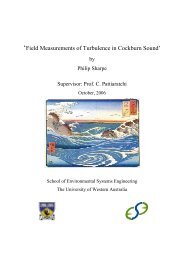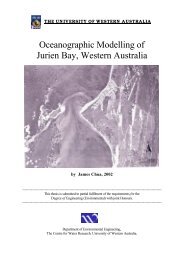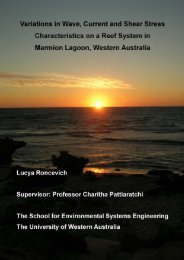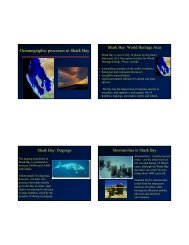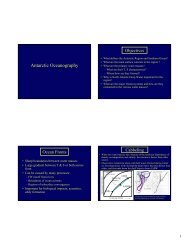Directional Waves in the Nearshore Coastal Region of Perth ...
Directional Waves in the Nearshore Coastal Region of Perth ...
Directional Waves in the Nearshore Coastal Region of Perth ...
Create successful ePaper yourself
Turn your PDF publications into a flip-book with our unique Google optimized e-Paper software.
<strong>Directional</strong> waves <strong>in</strong> <strong>the</strong> nearshore coastal region <strong>of</strong> <strong>Perth</strong>, Western AustraliaHuey Jean Tan2.4.3 Regimes <strong>of</strong> Sea breeze and Storm events <strong>in</strong> <strong>Perth</strong>Sea breezesThe sea breeze system is a diurnal atmospheric circulation due to <strong>the</strong> differential heat<strong>in</strong>g <strong>of</strong><strong>the</strong> land and sea surfaces caus<strong>in</strong>g a pressure gradient, which leads to streams <strong>of</strong> air flow<strong>in</strong>gonshore or <strong>of</strong>fshore until balance is restored (BOM 1993). Sea breezes are a dist<strong>in</strong>ctive andwell established feature <strong>of</strong> <strong>the</strong> local climate <strong>in</strong> <strong>the</strong> south-west <strong>of</strong> Australia, and are given localnames such as <strong>the</strong> Fremantle Doctor, Albany Doctor, and Esperance Doctor “from <strong>the</strong> name<strong>of</strong> <strong>the</strong> coastal locality near which <strong>the</strong>y cross <strong>the</strong> shore on <strong>the</strong>ir welcome way <strong>in</strong>land.” (Gentilli1971 p.111). A typical sea breeze cycle usually consists <strong>of</strong> <strong>of</strong>fshore w<strong>in</strong>ds <strong>in</strong> <strong>the</strong> generaleasterly direction <strong>in</strong> <strong>the</strong> morn<strong>in</strong>g, followed by <strong>the</strong> sudden arrival <strong>of</strong> south to southwesterly(alongshore to cross-shore) w<strong>in</strong>ds towards mid-afternoon. The sea breeze is present more than60% <strong>of</strong> <strong>the</strong> time dur<strong>in</strong>g <strong>the</strong> summer months, and <strong>the</strong> mean sea breeze velocity at <strong>the</strong> coastl<strong>in</strong>eis about 8 ms -1 (Massel<strong>in</strong>k & Pattiaratchi 2001). W<strong>in</strong>d speeds dur<strong>in</strong>g <strong>the</strong> summer sea breeze<strong>of</strong>ten exceed 15ms -1 with maximum values <strong>of</strong> 20 ms -1 (Pattiaratchi et al 1997).In contrast to <strong>the</strong> ‘typical’ sea breeze system which blows perpendicular to <strong>the</strong> shorel<strong>in</strong>e, <strong>the</strong>sea breeze along <strong>the</strong> west coast <strong>of</strong> Australia blows parallel to <strong>the</strong> shorel<strong>in</strong>e <strong>in</strong> a sou<strong>the</strong>rlydirection (Pattiaratchi et al 1997). The reason for <strong>the</strong> shore-parallel sea breeze system can beattributed to <strong>the</strong> <strong>in</strong>teraction between <strong>the</strong> sea breeze system and <strong>the</strong> synoptic wea<strong>the</strong>r patterns.Dur<strong>in</strong>g summer, <strong>the</strong> Australian cont<strong>in</strong>ent is generally under <strong>the</strong> <strong>in</strong>fluence <strong>of</strong> easterly air flow,and due to <strong>the</strong> heat<strong>in</strong>g <strong>of</strong> <strong>the</strong> air flow across <strong>the</strong> cont<strong>in</strong>ent, a low pressure trough is formedparallel to <strong>the</strong> coast <strong>of</strong> Western Australia (i.e. <strong>in</strong> a north-south direction) (Pattiaratchi et al1997). The location <strong>of</strong> <strong>the</strong> trough affects <strong>the</strong> <strong>in</strong>tensity and direction <strong>of</strong> <strong>the</strong> sea breeze. Thesynoptic pressure gradient acts <strong>in</strong> a nor<strong>the</strong>asterly direction when <strong>the</strong> low pressure trough islocated <strong>in</strong>land from <strong>the</strong> west coast (Pattiaratchi et al 1997). If we consider <strong>the</strong> sea breezesystem on <strong>the</strong> West Australian coast as simply due to <strong>the</strong> differential heat<strong>in</strong>g <strong>of</strong> land and seasurfaces and <strong>the</strong> Coriolis force, <strong>the</strong> sea breeze would flow <strong>in</strong> a southwesterly direction. Hence<strong>the</strong> comb<strong>in</strong>ation <strong>of</strong> <strong>the</strong> southwesterly air flow <strong>of</strong> <strong>the</strong> sea breeze pressure system and <strong>the</strong>sou<strong>the</strong>asterly air flow <strong>of</strong> <strong>the</strong> synoptic pressure results <strong>in</strong> a sou<strong>the</strong>rly sea breeze. When <strong>the</strong>location <strong>of</strong> <strong>the</strong> trough is such that <strong>the</strong> synoptic pressure gradient <strong>in</strong>duces sou<strong>the</strong>rly w<strong>in</strong>ds, <strong>the</strong>sea breeze enhances <strong>the</strong> sou<strong>the</strong>rly w<strong>in</strong>ds (Pattiaratchi et al 1997). Therefore <strong>the</strong> summersynoptic patterns <strong>in</strong> this region heighten <strong>the</strong> sea breeze system, and very strong sea breezesoccur dur<strong>in</strong>g <strong>the</strong> summer months. The deepest sea breezes at <strong>Perth</strong> occur <strong>in</strong> November to20 Literature Review



